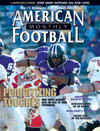AMERICAN FOOTBALL MONTHLY THE #1 RESOURCE FOR FOOTBALL COACHES
Article CategoriesAFM Magazine
|
AFM Subscribers Ask...with Glenn Carusoby: Glen CarusoHead Coach, Macalaster College © More from this issue Macalester Collegeís football program began a new era on December 16, 2005 when the college named Glenn Caruso its new football coach. In his previous position as offensive coordinator at South Dakota, Caruso directed an offense that set 117 school records including points scored and total yardage. In 2005, the Coyotes went 9-2 while averaging 49.7 points and 583 yards per game. Last fall, in his first season as Macalesterís head coach, the Scots produced their two highest single-game, total yardage games in school history. The staple of both the USD and now Macalester offense is the Pass Action Run: a concept to soften up defenses at the snap by giving them a pass key first in order to run the ball directly at them. The Scots averaged 8.3 yards per carry every time this play was called last year. Coach Caruso recently completed a series ....The full article can only be seen by subscribers. Subscribe today!
|
|
|||||||
| HOME |
MAGAZINE |
SUBSCRIBE | ONLINE COLUMNISTS | COACHING VIDEOS |
Copyright 2025, AmericanFootballMonthly.com
All Rights Reserved





